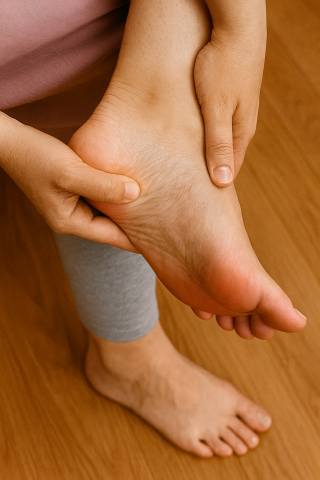Why Plantar Fasciitis Isn’t Really About a “Tight” Fascia
By Michelle Champlin, Chief Podiatrist – Dubai Podiatry Centre
Plantar fasciitis is one of the most common and painful foot conditions we see in clinic. It causes sharp, stabbing heel pain—especially when getting out of bed in the morning or after sitting for a while. But the name plantar fasciitis can actually be misleading.

Understanding the Plantar Fascia
The plantar fascia is a thick, collagen-like band that runs from the heel bone to the toes. It acts like a suspension bridge to keep the foot’s arches intact and to stabilise every step you take.
Because the plantar fascia is made of densely woven collagen fibres, it’s extremely strong but not very stretchy. Many articles suggest “stretching” the fascia, but in truth, it doesn’t tighten—it becomes pulled taut when the foot’s structure begins to collapse.
Why It Happens
When you have healthy arches, the plantar fascia works quietly in the background to keep your foot stable. But when one or more of your foot’s three main arches—
- the medial arch (inside edge of the foot),
- the lateral arch (outer edge), or
- the transverse arch (across the ball of the foot)—
- start to flatten or your ankle leans inward or outward, the fascia is forced to work overtime.
That constant tension at its attachment into the heel bone causes tiny micro-tears in the outer casing of the bone, leading to inflammation and pain.
Why the Pain Comes and Goes
When you sit or sleep, inflammation builds up in the casing around the heel bone. The moment you stand up, pressure on that area causes intense pain. After walking a few minutes, your calf muscles begin to pump blood through the foot, draining the inflammation and easing the discomfort—until you sit again.
That’s why many people describe their first steps out of bed as agonising, but feel somewhat better once they “get moving.”
Who Gets Plantar Fasciitis—And Who Doesn’t
Interestingly, people with genuinely flat feet rarely get plantar fasciitis, because their fascia never needs to engage—it’s already at rest. The condition typically affects those whose arches are collapsing under load, not those whose arches are already fully flat.

The Real Solution: Structural Correction
Treating the heel pain directly—ice, massage, or anti-inflammatory creams—only addresses the symptom. The long-term solution is to correct the structure of the foot so that the fascia no longer has to overwork.
This might involve:
- Custom orthotics to lift the medial and transverse arches
- Supporting the ankle to stop it leaning in or out
- Strengthening the calf and intrinsic foot muscles
Once the arches are properly supported, the fascia relaxes and the inflammation at the heel naturally subsides.
Healing Time: 12–14 Weeks
True healing takes time. The recovery process for plantar fasciitis typically spans 12 to 14 weeks.
You can imagine the heel bone where the plantar fascia attaches as a large window that has had a stone thrown at it, causing tiny micro-fractures across the glass.
- During the first six weeks, the outer edges of the “window” begin to self-heal.
- Over the next six weeks, the centre, or the “bull’s-eye” where the impact was greatest, gradually repairs.
- The final two weeks allow for complete healing and realignment.
This is why genuine corrective orthotic therapy, which lifts and supports all three arches of the foot and stabilises the ankle, requires this full 12–14 week period—to give the plantar fascia the rest it needs for complete recovery.
A Helpful Analogy
Imagine the plantar fascia like a strong sticker on a wall. If you start to peel it off, some paint and plaster may come away, but the concrete beneath is still intact. That’s similar to what happens when the fascia pulls on the heel bone—micro-damage occurs, but the structure can heal once tension is reduced.
Another way to picture it: think of the heel bone as a ceiling with a hidden water bubble. When you sleep, fluid builds up in that bubble, and when you stand, it’s suddenly compressed—painful until movement drains it away.
In Summary
Plantar fasciitis isn’t simply inflammation of a “tight” band. It’s a structural response to stress in the foot’s architecture. Correct the mechanics, and the pain goes away naturally.
If you suffer from heel pain, especially first thing in the morning, book a biomechanical assessment with our podiatrists. By identifying which arch is collapsing, we can design a treatment that targets the cause—not just the symptom.
#PlantarFasciitis #HeelPain #HeelPainRelief #DubaiPodiatryCentre #FootPain #FlatFeet #ArchSupport #OrthoticsDubai #Podiatry #FootCare #Biomechanics #HealthyFeet #Footerella #PodiatristDubai #DubaiHealth
For more information or to book an appointment please call our clinic +971 4 3435390 or WhatsApp +971 50 3553024

